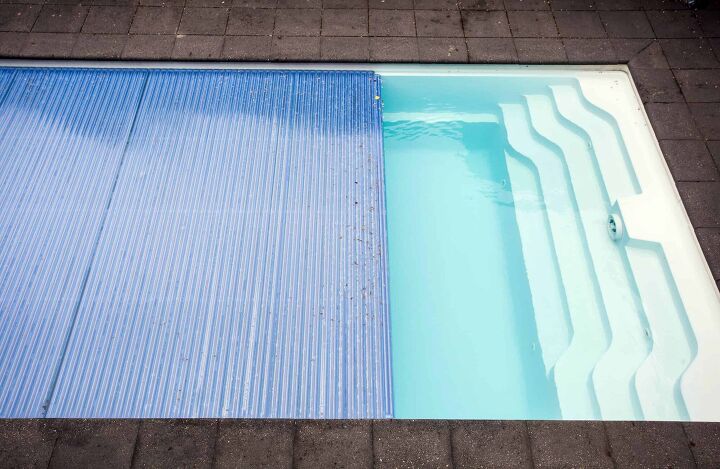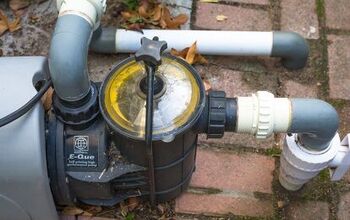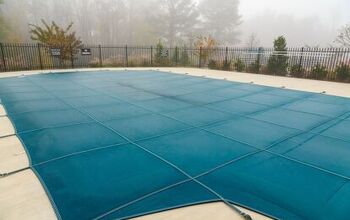Can You Run a Pool Pump With The Solar Cover On?

A solar cover is a great addition to your heated or non-heated pool. If your pool has a heater, you will have to retain all the heat you can. If it is heated, saving heat with a solar cover is a great way to save money.
There are many things to consider when you are a pool owner. Perhaps most importantly, your pool’s pump runs the filtration system and keeps all of the water circulating. It is invaluable for keeping your water clean and suitable for swimming.
It is perfectly safe to run the pump while the solar cover is on the pool. It is recommended that you run the pump 5-12 hours a day depending on the weather. With the solar cover on, you can conserve heat while the water circulates.
In this article, we will cover many aspects of solar covers and pumps. By running the pump with the cover on, you can save time and money on pool maintenance.
Do You a Need Pool, Spa, or Hot Tub Contractor?
Get free, zero-commitment quotes from pro contractors near you.

What Is a Solar Cover?
A solar cover is a large, thermal blanket that covers the length and width of your pool. These blankets are usually made of plastic and look like huge sheets of bubble wrap. However, the material they are made of is specifically designed to trap heat and keep it in the water.
Solar covers float on the surface of the pool and don’t require any fasteners or tie downs. During the day, they absorb the sun’s rays and transfer that heat to the pool. They also help prevent water evaporation which is a huge source of heat loss for swimming pools.
Since the cover is not fastened to anything, it can be difficult to put on and take off. Because of this, there are special reels designed to help you wrap them up. It is very important to remember that you should never swim in the pool with the solar cover on.
How Does a Solar Cover Work?
Solar covers work by transferring heat from the sun into the water. Not only do they add heat, but they also keep it from escaping during cooler weather. Keeping your solar cover on as much as possible will ensure that your pool is retaining the heat it needs.
The solar cover must be placed on the batter bubble side down. The bubbles are what keep the cover afloat. They also act as little magnifying glasses that increase the energy the cover receives from the sun.
Solar Covers also keep debris and dirt out of the pool. In this way, they work in tandem with the pump to make sure nothing gets caught in the filters. By using both of these tools, you can be sure your pool stays clean and warm.
Benefits of Using a Solar Cover
In addition to heating your pool, there are a number of benefits to using a solar cover. Here are some of the main reasons why you might want to consider investing in one of them for your pool:
- It cuts down on evaporation. Without a pool cover, your pool can lose an average of two inches of water each week. When you put this into perspective, depending on the size of your pool this could add up to around 10,000 or 20,000 gallons a year. However, solar pool covers almost completely eliminate evaporation, reduce heat loss, and save you money on having to replace water.
- It prevents chemical loss. As water evaporates, the pool chemicals are reduced or diluted. A solar cover can decrease your chemical reduction by around 60%.
- It saves energy. The average gas pool heater uses roughly four gallons per hour with propane and four therms per hour with natural gas. Whereas an electric heat pump uses five kilowatts per hour of electricity. A solar pool cover requires neither gas nor electricity and can effectively save you a large sum of money on your energy bill.
- It provides a longer swim season. With your solar cover keeping your pool water warm, you’ll be able to enjoy a comfortable swim far into fall, depending on where you live, of course.
- It limits algae and debris in your pool. While this is true of any pool cover, it’s still important to mention that solar cover’s cut down on pesky debris and algae spores. This effectively keeps your pool cleaner longer and reduces the amount of maintenance needed.
Solar Cover Storage
One of the hardest things to deal with when using a solar cover for your pool is the storage. They are often large and unwieldy and must be stored correctly. Without proper storage, your solar cover could become tangled up or ripped.
To remedy this, you can get a reel as described above. You can also cut your cover into multiple pieces. This makes it easier to roll up properly as opposed to working with one giant sheet.
How Does a Pool Pump Work?
In general, pool pumps are centrifugal pumps. This means that they use centrifugal force to make water move through the system. This happens through an inlet and outlet where the water is brought in and expelled out into the pool.
Once the water is in the filtration system, it is run through a series of smaller and smaller filters. These filters will catch any debris or dirt that may have made its way into the pool. By the time it comes out the other end, it is completely clean.
Obviously, the more you use your pool, the more you are going to have to run the pump. This means that you are going to have to clean the filters quite often. By doing this, you can avoid clogs and potential expensive equipment failure.
Running the Pump at Night
In a perfect world, you would be able to run your pump 24 hours a day, 7 days a week. This would be a great situation, and your pool would always be clean. However, most people wouldn’t be able to afford the electric bill that would rack up.
By running the pump at night, you can clean out any debris that has built up during the day. With the solar cover on, you can be sure no dirt, leaves, or even frogs are getting in. This is a great way to retain heat while the water is being cleaned.
One downside of running the pump at night is that the water is then not getting cleaned during the day. If you only run the pump overnight, dirt and debris could build up while the pool is at peak use. This is a problem during the summer months when everyone is swimming a lot.
Running the Pump During the Day
The advantage of running the pump during the day is that it is being cleaned while it is at peak use. This will ensure that dirt and debris don’t build up in the pool while it’s being used. This could be a good option for pools that see a lot of use.
The downside of running the pump during the day is that it is often more expensive. Peak power hours are generally in the afternoon. This means that your daytime pool cleaning will cost more than running the pump overnight when electricity is cheaper.
Pump Maintenance
One of the most expensive things to replace on a pool is the filter pump. The key to longevity with your pool pump is regular maintenance. Making sure that it is clean and in good working order year-round is crucial.
At least once every three months, check your pool pump’s filters and backwash. These parts of the pump often get clogged with debris. This can lead to motor failure so it is important that they are cleared out regularly.
Related Questions
Do solar covers work?
If your solar cover is correctly fitted to your pool and is stored properly when not in use, it will work. Covers are designed to amplify heat they receive from the sun, transfer it to the water, and keep it in.
Does leaving a solar cover on cause algae?
Algae is an unfortunate reality of having a pool. It grows in warmer conditions and can cause your pool to “go green” and become unsafe to swim in. Leaving the cover on will make the water warmer but if you have a functioning pump, algae will not build up more than usual.
How long can I leave a pool cover on?
The longest you should leave a solar cover on your pool is 7 days. By removing the cover and checking the quality every 7 days, you can be sure your water is in top condition.
How long does a solar cover last?
Just like anything, your solar cover is going to deteriorate over time. When bubbles begin to fall off or the cover starts to flake, these are indications that it’s time to replace your solar cover. The average lifespan of a pool solar cover is three years, although many replace them much more frequently.
Do You a Need Pool, Spa, or Hot Tub Contractor?
Get free, zero-commitment quotes from pro contractors near you.

Final Thoughts
A pump and a solar cover are great ways to keep your pool in top condition. By using both of them at the same time, you can be sure that there are no harmful bacteria or debris floating around. You can rest easy knowing that it is perfectly safe and even encouraged.
Related Guides

We are a team of passionate homeowners, home improvement pros, and DIY enthusiasts who enjoy sharing home improvement, housekeeping, decorating, and more with other homeowners! Whether you're looking for a step-by-step guide on fixing an appliance or the cost of installing a fence, we've here to help.
More by Upgraded Home Team
















![10 Most Dangerous Neighborhoods in Baltimore [Updated]](https://cdn-fastly.upgradedhome.com/media/2023/07/31/9075655/10-most-dangerous-neighborhoods-in-baltimore-updated.jpg?size=350x220)










